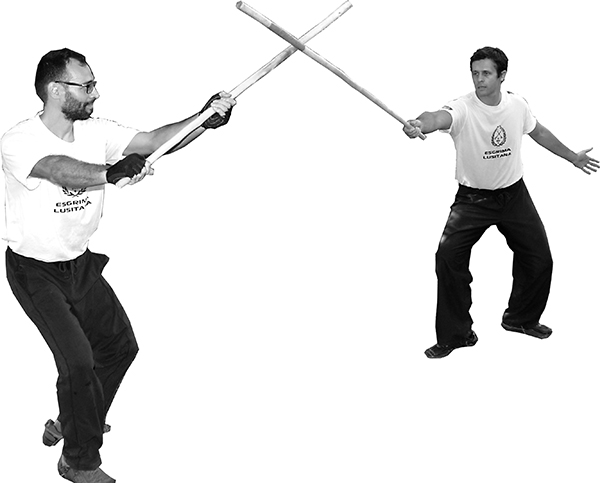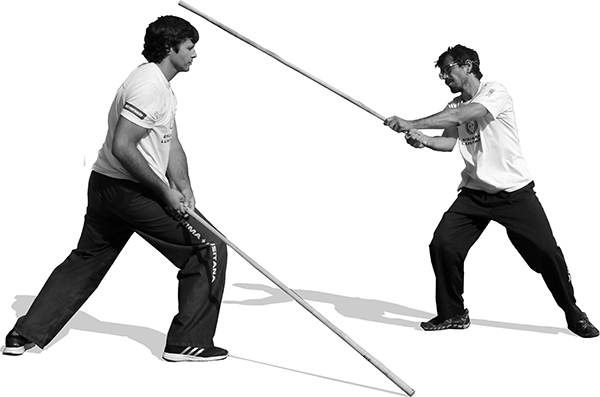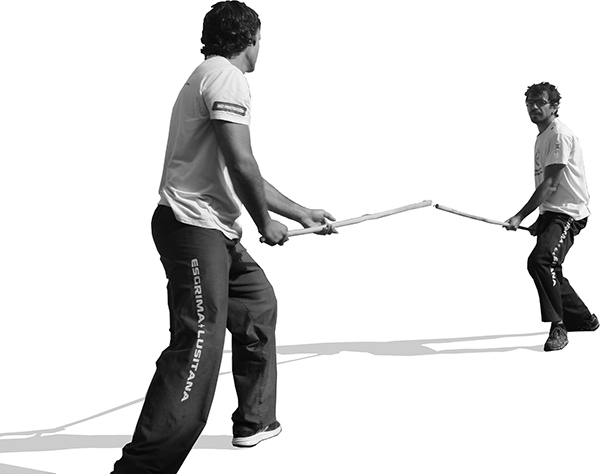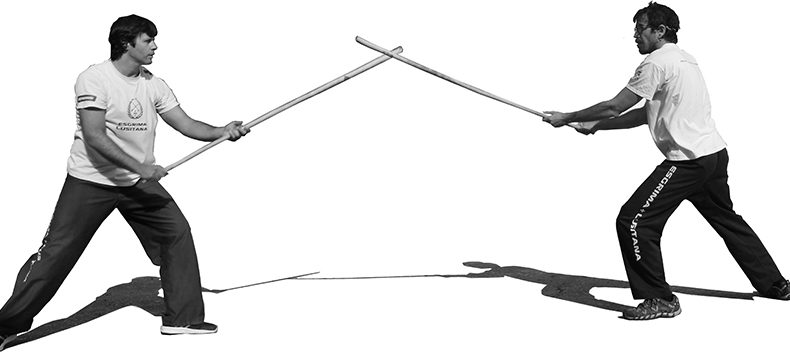We must always keep in mind that using a stick with approximately 1,5m gives us the possibility of reaching an opponent at a distance and defend any attack that is directed at us, however it has its advantages and disadvantages.
Our technique covers all aspects inherent to this condition: movement, time and distance must always be trained, repeated, tested and perfected so that these disadvantages are canceled and the use of our weapon is fully exploited.
In this article, we approach the distance in Jogo do Pau – Portuguese Stickfighting in situations of 1 to 1, with wooden sticks, not taking into account other aspects such as the surrounding space, obstacles, opponents with weapons of different sizes from ours and other potential threats or opponents. We can address these aspects in later articles.
Distance in Jogo do Pau – Portuguese Stickfighting
Distance is one of the aspects most developed and trained in our technique, and its importance is transverse to all schools of Jogo do Pau and even other martial arts with weapons. At our school, this study was carried out to the utmost detail and tested in real combat situations.
As mentioned above, it is only through training and understanding of the technical characteristics of the use of a weapon (varapau), with a dimension of approximately 1,5 m, that the total advantage of our technique can be achieved and, consequently, achieve effectiveness. In this article, we focus on only one of the aspects that should be considered when handling this weapon, namely distance. However, this factor only makes sense when used in conjunction with others such as defense and attack time or combat tactics, among others …
The first concept to understand in terms of distance is that it is not a fixed measure, there are several distances that we have to keep in mind, combat is not a static exercise, it consists of several movements in the search for weaknesses or openings on the part of the opponent in search of safer distances, and, of course, in attacks, counterattacks and defenses.
Defense distance

Area that surrounds us and within which we can not allow the opponent’s weapon to enter. This distance is usually measured between our body, specifically the area of our body being attacked, and the point of our weapon (area of our weapon that intercepts the opponent’s weapon).
It is irrelevant to the case if we are to move in the opposite direction to attack (away from the striker – “sair” or “recuar”), or if we are making a defense on the move in the opposite direction to the attack (approaching the striker – “avançar” or “crescer”) the base question remains: we must ensure that we intercept the opponent’s attack with the tip of our weapon as far as possible from the area of our body being attacked.
Attack distance

Maximum distance that allows us to hit the opponent with the tip of our weapon, and return quickly to a safe defense. This measure is simple enough to characterize: You are at the correct distance when with arms stretched griping one end of your weapon you can reach the opponent with the furthest point of your weapon. We do not want this distance to be shorter for several reasons:
- If you can hit with the end of your stick, you are already beating at maximum speed and causing maximum damage, the closer you are to the impact area of your weapon the less force / speed the attack will have;
- It is possible that the opponent defends your attack, in which case you should be at a distance that allows a safe defense;
- At the limit, your opponent can get very close at a distance where the blow becomes very weak and defensible even with the hands / arms and enter close combat (hand to hand).
Combat Distance

Distance to the opponent that allows us to quickly put ourselves at a distance to hit him (attack distance), or move us to a distance that allows a safe defense (defense distance). It is important to note that the move to the defense can not be such as to preclude the counterattack or make it too slow, the distance during our defensive move must be the minimum / sufficient to allow the defense and a fast counterattack that hits the opponent.
In short, we must always train in the way that most closely approximates real combat situations, only training with attacks on the body can mechanize our attacks and only by receiving these same attacks can we train effective defenses.
Make life easier for our opponent with short attacks (wrong distances) or easily defensible, harms our training. Leading to mechanization of wrong and ineffective technical movements, but also affect the training of our partner giving him a false sense of security and leading to the mechanization of defenses with wrong distances.
Written by: Ricardo Moura – Jogo do Pau Cascais
Photos by: Esgrima Lusitana
